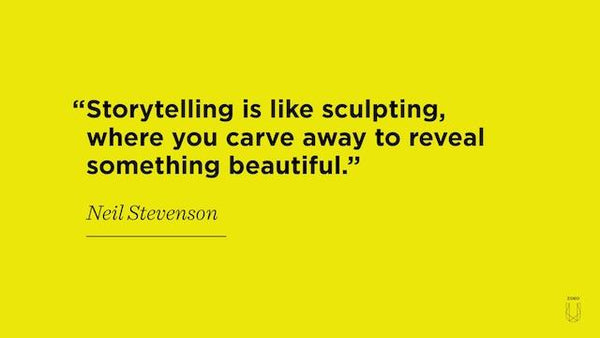Chasing Creativity: The Never-ending Journey
“Fear is the sign that a growth-inducing challenge might lie ahead.”
- Neil Stevenson, High Wizard Of Chaos at IDEO
We sat down with IDEO's Neil Stevenson to hear about his year exploring creativity and his insights into the art of storytelling. Here are a few of our favorite highlights:
The Bar Test, Prototype Your Story
Next time you have to communicate something in the work environment, practice communicating it first to your friends over beers, coffee, or tea. We call this the “bar test,” a verbal story prototype that we teach in our Storytelling for Influence course. Prototype your story ideas by talking them out in a human context before writing them down in a professional context.
The Danger of Expertise
There’s this danger in the comfort of expertise and there’s huge value in putting yourself in situations where you’re the opposite of an expert—where you’re a beginner, where you’re learning. Try putting yourself in situations that have an intentional level of discomfort. This is often a stepping point toward bold new learning.

The Importance of Fear in Creativity
It’s easy to think of fear as a warning, but in the creative context, fear can sometimes be a beacon that you’re going into new, growth-inducing territory. All forms of creativity involve some sort of dissonance and there’s often a feeling of, maybe I shouldn’t do this. There's a policeman inside your head, and he must be destroyed. In the context of storytelling, in order to conquer (or minimize) your fear you really need to get out and take action. There’s a tendency for people to wait and wing it with their stories and presentations.
Less Like a Powerpoint, More Like a Campfire
Make your stories and presentations more impactful by imagining them as time around the campfire with your audience. Partner with your audience and remember a story is an emotional journey.
A Neverending Journey
Chasing creativity is kind of like chasing a rainbow. You only have one life, you should push yourself to do all the things that seem scary to you. The act of doing it will immediately push you somewhere new.
---
Chasing Creativity webinar chapters
(1:49) Neil’s background: Neil’s journey from journalism to becoming a storyteller at IDEO to his current explorations in creativity.
(5:17) Storyteller in a maker culture: Bringing storytelling to the maker culture of IDEO. Stuff versus fluff.
(8:49) IDEO stories: Amplifying storytelling at IDEO through evenings of sharing personal stories and equipping people with tools and processes for telling better stories.
(10:44) Course overview: 3 lessons of Storytelling for Influence course: how to write a great brief and understand your audience, how to prototype a story, the craft of storytelling.
(12:05) The Bar Test - tips for telling better stories: Prototyping stories verbally to practice communicating something in a human context (as opposed to a professional context).
(16:16) Midlife crisis + exploring creativity: The danger of becoming an expert and losing creativity.
(19:19) Seeking discomfort in pursuit of creativity: From the awkward experience of improv classes to the terror of stand-up comedy, if it sounds terrifying that’s probably a good thing.
(24:01) Creative methods + mindsets: Mastering the methods in service of putting yourself in creative, nonlinear mindsets.
(25:30) Street art + getting in touch with fear: All forms of creativity involve some kind of dissonance and often there’s a feeling from others or yourself that maybe I shouldn’t do this.
(30:02) Fear of public speaking: Confront the fear head on in small ways, own the nervousness, and practice.
(32:28) Deadly sins of storytelling: Being boring, reading the slides, turning your back on the audience.
(34:09) Course assignments: 4-week long course with a final project. Each weekly lesson has an accompanying assignment.
(35:48) A story simple enough for a 3-year-old: Forces you to remove the jargon, focus on what’s most interesting, and keep things succinct.
(39:30) Creative storytelling presentations: Getting away from the powerpoint mindset and into the sitting around a campfire mindset. Creating more of a sense of wonder and curiosity.
(41:38) Adjusting your story style on the spot: Be careful not to talk too fast and remember to check in with your audience.
(44:04) Start at the beginning, middle, or end: Depends on your audience and your story. Remember stories are an emotional journey.
(45:03) Go to tool for thinking more creatively: Think about emotional turning points in stories, the moments of struggle or discovery, and amplify those points.
(47:10) Chasing a rainbow: Try new things in creativity and take on things that make you nervous.
Learn how to create a great brief, better understand your audience, prototype your story, and hone your narrative—learn the craft of storytelling. Check out our Storytelling for Influence online course.
- choosing a selection results in a full page refresh
- press the space key then arrow keys to make a selection



